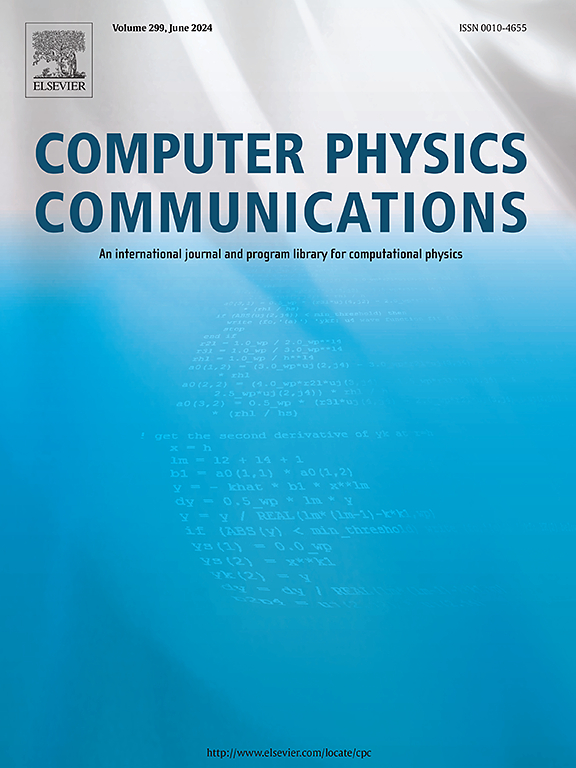ALATDYN:一套用于计算结晶固体的热力学和热输运性质的非调和晶格动力学代码
IF 7.2
2区 物理与天体物理
Q1 COMPUTER SCIENCE, INTERDISCIPLINARY APPLICATIONS
引用次数: 0
摘要
我们介绍了一个晶格动力学包计算弹性,热力学和热输运性质的晶体材料的力和势能的数据作为原子位置的函数。数据可以来自密度泛函理论(DFT)计算或在超级单体中进行的经典分子动力学运行。首先,从后两次运行中提取模型势参数,即非调和力常数。然后,一旦定义了非调和模型,就可以分别使用晶格动力学、玻尔兹曼输运理论和变分原理计算有限温度下的热导率和平衡性质。此外,该软件还计算了弹性张量、Gruneisen参数和准谐波近似(QHA)下的热膨胀系数等力学性能。声子,弹性常数和热力学性质的结果应用于锗晶体将说明。利用力常数作为力场,人们还可以进行分子动力学(MD)模拟,以研究微扰理论之外的非调和性和缺陷散射的联合效应。程序摘要程序标题:ALATDYNCPC库链接到程序文件:https://doi.org/10.17632/4jm4fh2nk2.1Developer's存储库链接:https://github.com/KeivanS/Anharmonic-lattice-dynamics/tree/mainLicensing条款:gplv3编程语言:fortran90问题的性质:ALATDYN代码套件开发了晶体固体的晶格动态模型。FOCEX代码从超级单体计算数据中提取力与位置的模型参数,并在准谐波近似下计算声子谱、弹性常数和热力学性质。SCOP8代码超越QHA,实现自洽声子理论,使自由能相对于应变张量、原子位置和调和力常数最小,从而得到给定温度下的平衡状态以及有效声子带结构。THERMACOND代码利用立方力常数和晶体对称性有效地求解声子玻尔兹曼方程(PhBE)并推导出热导率。最后,ANFOMOD利用提取的力常数在超级单体中进行分子动力学模拟。求解方法:力常数由奇异值分解(或脊回归)法得到。该方法首先建立碰撞矩阵,并利用共轭梯度法对其进行有效反演。附加注释,包括限制和不寻常的功能:这个代码有能力提取力常数高达8阶,只要提供足够的力-位移数据。SCOP8因此可以使用它们来潜在地预测相变。声子与磁自由度或轨道自由度的耦合是我们计划在未来添加到FOCEX和SCOP8代码中的一个扩展。本文章由计算机程序翻译,如有差异,请以英文原文为准。
ALATDYN: A set of Anharmonic LATtice DYNamics codes to compute thermodynamic and thermal transport properties of crystalline solids
We introduce a lattice dynamics package which calculates elastic, thermodynamic and thermal transport properties of crystalline materials from data on their force and potential energy as a function of atomic positions. The data can come from density functional theory (DFT) calculations or classical molecular dynamics runs performed in a supercell. First, the model potential parameters, which are anharmonic force constants are extracted from the latter runs. Then, once the anharmonic model is defined, thermal conductivity and equilibrium properties at finite temperatures can be computed using lattice dynamics, Boltzmann transport theories, and a variational principle respectively. In addition, the software calculates the mechanical properties such as elastic tensor, Gruneisen parameters and the thermal expansion coefficient within the quasi-harmonic approximation (QHA). Phonons, elastic constants and thermodynamic properties results applied to the germanium crystal will be illustrated. Using the force constants as a force field, one may also perform molecular dynamics (MD) simulations in order to investigate the combined effects of anharmonicity and defect scattering beyond perturbation theory.
Program summary
Program Title: ALATDYN
CPC Library link to program files: https://doi.org/10.17632/4jm4fh2nk2.1
Developer's repository link: https://github.com/KeivanS/Anharmonic-lattice-dynamics/tree/main
Licensing provisions: GPLv3
Programming language: FORTRAN90
Nature of problem: The ALATDYN suite of codes develops a lattice dynamical model of a crystalline solid. The FOCEX code extracts the model parameters from supercell calculations data on forces versus position and calculates the phonon spectrum, elastic constants and thermodynamic properties within the quasi-harmonic approximation. The SCOP8 code goes beyond QHA and implements the self-consistent phonon theory to minimize the free energy with respect to the strain tensor, atomic positions and harmonic force constants, and thus obtains the state of equilibrium at the given temperature along with the effective phonon bands structure. The THERMACOND code uses the cubic force constants and the crystal symmetries to solve the phonon Boltzmann equation (PhBE) efficiently and deduce the thermal conductivity. Finally, ANFOMOD uses the extracted force constants to perform a molecular dynamics simulation in a supercell.
Solution method: Force constants are obtained from a singular value decomposition (or the ridge regression) method. PhBE is solved by first setting up the collision matrix and effectively inverting it using the conjugate-gradients method.
Additional comments including restrictions and unusual features: This code has the ability to extract force constants up to 8th order provided enough force-displacement data is provided. SCOP8 can thus use them to potentially predict phase changes. Coupling of phonons to magnetic or orbital degrees of freedom is an extension we plan to add to the FOCEX and SCOP8 codes in the future.
求助全文
通过发布文献求助,成功后即可免费获取论文全文。
去求助
来源期刊

Computer Physics Communications
物理-计算机:跨学科应用
CiteScore
12.10
自引率
3.20%
发文量
287
审稿时长
5.3 months
期刊介绍:
The focus of CPC is on contemporary computational methods and techniques and their implementation, the effectiveness of which will normally be evidenced by the author(s) within the context of a substantive problem in physics. Within this setting CPC publishes two types of paper.
Computer Programs in Physics (CPiP)
These papers describe significant computer programs to be archived in the CPC Program Library which is held in the Mendeley Data repository. The submitted software must be covered by an approved open source licence. Papers and associated computer programs that address a problem of contemporary interest in physics that cannot be solved by current software are particularly encouraged.
Computational Physics Papers (CP)
These are research papers in, but are not limited to, the following themes across computational physics and related disciplines.
mathematical and numerical methods and algorithms;
computational models including those associated with the design, control and analysis of experiments; and
algebraic computation.
Each will normally include software implementation and performance details. The software implementation should, ideally, be available via GitHub, Zenodo or an institutional repository.In addition, research papers on the impact of advanced computer architecture and special purpose computers on computing in the physical sciences and software topics related to, and of importance in, the physical sciences may be considered.
 求助内容:
求助内容: 应助结果提醒方式:
应助结果提醒方式:


